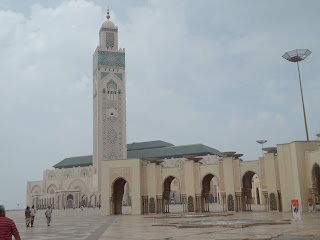Morocco has more cultures to explore then the average tourist is
aware of. In fact, I traveled there solo a few years ago and noticed bits of
it. But it wasn't until I took Morocco Sahara Odyssey with Overseas Adventure Travel, that I was able to truly experience the country and learn about all the
cultural influences. And to me, this was pure bliss.
 |
| Ritual public bathing before call ot prayer |
Cultural variances can be seen
as soon as arrival in Casablanca. Although the language there is French and
Arabic, Casablanca is clearly Spanish for "white house". In fact, the
white house from which the city derives its name is located on the coast. I saw
it when I arrived a couple of days early and had a driver and guide take me up
the coast to the once Portuguese occupied town of Al Jedda among others. The
Portuguese cannons facing the water can be seen in various parts of the country
up and down the coast.
 |
| Photos: Jann Segal |
When the tour began, we soon
left French Morocco for Spanish Morocco when we started the pre trip to the
blue city of Chefchouen, which also included a couple nights in Tangiers.
Although my French is choppy (and my Spanish choppier), I enjoyed speaking with
the locals we met along the way in the little Spanish I know for this part of
the trip. When we later started the base trip in Rabat, it was back to using my
butchered French. Although while in Tangiers, it was geographically fun to see
the coast of southern Spain and Gibraltar, and to stop in the spot that is the
exact confluence of the Atlantic and Mediterranean oceans. Having been in
southern Spain years ago, it was fun to be on the other side of the great
divide.
With all these different
nationalities having invaded or having otherwise been part of Moroccan history,
religions followed. The original Moroccans were Berber and were considered
pagan. Many converted to Judaism. And of course, during the time of the
Inquisition in the 1400s, many Jews fled Spain and Portugal for the safety of
Morocco. But many also became " New Christians," and thus
Christianity was introduced to Morocco.
 |
| Torah on 9th century synagogue |
 |
| Stars of David on a Mosque |
We visited a 9th century
synagogue in Mekknes in northern central Morocco, complete with a torah, a mikvah and
even a place to make matzo for Passover. And while in Fez, where we were pretty
much locked into the 14th century, we saw Stars of David on buildings,
including on mosques in the Medina. These were not just symbols of peace we
were told as one would see in India; they were signs of true cooperation
between Judaism and the relatively newer Muslim religion.
The Jewish influence could be
seen everywhere; in pottery shops, where a good majority of the items for sale
had Stars of David on them or were meant for Jewish rituals like
the Sabbath; to the ordinary tourist shop, where very old Berber merchandise
was for sale, and which had Stars of David on them. Although the Jews in
Morocco were revered by the King at times in history and he held high
positions near him, after World War Two and the formation of Israel, they were
asked to leave Morocco. Although Jewish history in Morocco is long
and extensive, it also includes periods of persecution across the centuries. By
1948, when a significant number left Morocco, over quarter of a million
Moroccan Jews left, and only about 2,500 remain today. To underscore the more
violent part of this history, we saw a guillotine with a Star of David on it.
 |
| Nomadic People |
We also visited nomadic people
in the desert, who were likely more Berber in heritage than anything
else. In our visits with them, we saw a completely different class of
people than some of the more middle-class people we had been meeting. One
nomadic woman we met had lost all her teeth by the age of 25 because of the
heavy use of sugar with their tea, a common custom. We saw nomadic children on
bicycles in the Sahara, coming from seemingly nowhere to try to sell us goods.
It was so heart breaking, some of us just gave them money and told them to keep
their goods.
 |
| King Hussain 11 Mosque |
 |
| A Restaurant in Marrakesch |
But of course, today Morocco is
largely Muslim, and in French Morocco the language is combined with Arabic.
There are so many mosques in any one area, you can literally hear the
trope of a call to prayer coming from multiple mosques simultaneously, and
often it sounds in harmony with one another. Morocco can be many things to many
people, and French speaking Marrakesch is perhaps the most delightful of them
all. But as a sign of how it has also reached more modern times (well, at least the 1960's), right next to our riad inside the Medina was a restaurant with a huge silhouette of the four Beatles crossing Abbey
Road! It was even on the front of the menu.
As the owner explained to me with Beatles music playing in the background, his
favorites were John and George.
Yes, Morocco and all its varied cultures has something for
everyone indeed!
No comments:
Post a Comment